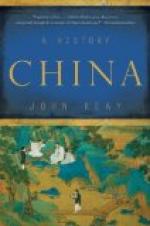4 Economic and social conditions
The internal changes of which there had only been indications in the first period of the Toba empire now proceeded at an accelerated pace. There were many different factors at work. The whole of the civil administration had gradually passed into Chinese hands, the Toba retaining only the military administration. But the wars in the south called for the services of specialists in fortification and in infantry warfare, who were only to be found among the Chinese. The growing influence of the Chinese was further promoted by the fact that many Toba families were exterminated in the revolts of the tribal chieftains, and others were wiped out in the many battles. Thus the Toba lost ground also in the military administration.
The wars down to A.D. 440 had been large-scale wars of conquest, lightning campaigns that had brought in a great deal of booty. With their loot the Toba developed great magnificence and luxury. The campaigns that followed were hard and long-drawn-out struggles, especially against South China, where there was no booty, because the enemy retired so slowly that they could take everything with them. The Toba therefore began to be impoverished, because plunder was the main source of their wealth. In addition to this, their herds gradually deteriorated, for less and less use was made of them; for instance, horses were little required for the campaign against South China, and there was next to no fighting in the north. In contrast with the impoverishment of the Toba, the Chinese gentry grew not only more powerful but more wealthy.
The Toba seem to have tried to prevent this development by introducing the famous “land equalization system” (chuen-t’ien), one of their most important innovations. The direct purposes of this measure were to resettle uprooted farm population; to prevent further migrations of farmers; and to raise production and taxes. The founder of this system was Li An-shih, member of a Toba family and later husband of an imperial princess. The plan was basically accepted in 477, put into action in 485, and remained the land law until c. 750. Every man and every woman had a right to receive a certain amount of land for lifetime. After their death, the land was redistributed. In addition to this “personal land” there was so-called “mulberry land” on which farmers could plant mulberries for silk production; but they also could plant other crops under the trees. This land could be inherited from father to son and was not redistributed. Incidentally we know many similar regulations for trees in the Near East and Central Asia. As the tax was levied upon the personal land in form of grain, and on the tree land in form of silk, this regulation stimulated the cultivation of diversified crops on the tree land which then was not taxable. The basic idea behind this law was, that all land belonged to the state, a concept for which the Toba could point to the ancient Chou but




